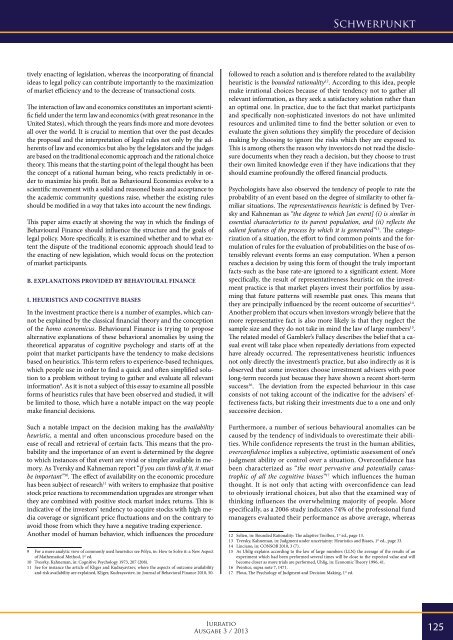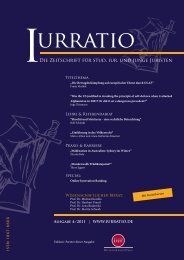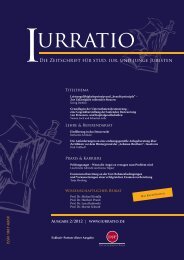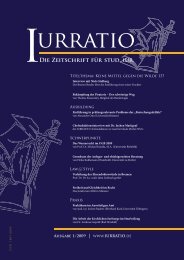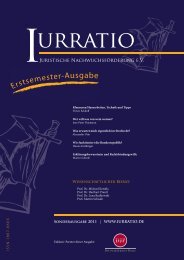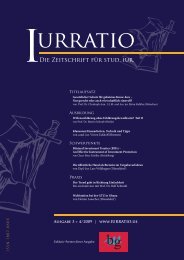Die Zeitschrift für stud. iur. und junge Juristen - Iurratio
Die Zeitschrift für stud. iur. und junge Juristen - Iurratio
Die Zeitschrift für stud. iur. und junge Juristen - Iurratio
Erfolgreiche ePaper selbst erstellen
Machen Sie aus Ihren PDF Publikationen ein blätterbares Flipbook mit unserer einzigartigen Google optimierten e-Paper Software.
Schwerpunkt<br />
tively enacting of legislation, whereas the incorporating of financial<br />
ideas to legal policy can contribute importantly to the maximization<br />
of market efficiency and to the decrease of transactional costs.<br />
The interaction of law and economics constitutes an important scientific<br />
field <strong>und</strong>er the term law and economics (with great resonance in the<br />
United States), which through the years finds more and more devotees<br />
all over the world. It is crucial to mention that over the past decades<br />
the proposal and the interpretation of legal rules not only by the adherents<br />
of law and economics but also by the legislators and the judges<br />
are based on the traditional economic approach and the rational choice<br />
theory. This means that the starting point of the legal thought has been<br />
the concept of a rational human being, who reacts predictably in order<br />
to maximize his profit. But as Behavioural Economics evolve to a<br />
scientific movement with a solid and reasoned basis and acceptance to<br />
the academic community questions raise, whether the existing rules<br />
should be modified in a way that takes into account the new findings.<br />
This paper aims exactly at showing the way in which the findings of<br />
Behavioural Finance should influence the structure and the goals of<br />
legal policy. More specifically, it is examined whether and to what extent<br />
the dispute of the traditional economic approach should lead to<br />
the enacting of new legislation, which would focus on the protection<br />
of market participants.<br />
B. Explanations provided by Behavioural Finance<br />
I. Heuristics and Cognitive Biases<br />
In the investment practice there is a number of examples, which cannot<br />
be explained by the classical financial theory and the conception<br />
of the homo economicus. Behavioural Finance is trying to propose<br />
alternative explanations of these behavioral anomalies by using the<br />
theoretical apparatus of cognitive psychology and starts off at the<br />
point that market participants have the tendency to make decisions<br />
based on heuristics. This term refers to experience-based techniques,<br />
which people use in order to find a quick and often simplified solution<br />
to a problem without trying to gather and evaluate all relevant<br />
information 9 . As it is not a subject of this essay to examine all possible<br />
forms of heuristics rules that have been observed and <strong>stud</strong>ied, it will<br />
be limited to those, which have a notable impact on the way people<br />
make financial decisions.<br />
Such a notable impact on the decision making has the availability<br />
heuristic, a mental and often unconscious procedure based on the<br />
ease of recall and retrieval of certain facts. This means that the probability<br />
and the importance of an event is determined by the degree<br />
to which instances of that event are vivid or simpler available in memory.<br />
As Tversky and Kahneman report “if you can think of it, it must<br />
be important” 10 . The effect of availability on the economic procedure<br />
has been subject of research 11 with writers to emphasize that positive<br />
stock price reactions to recommendation upgrades are stronger when<br />
they are combined with positive stock market index returns. This is<br />
indicative of the investors’ tendency to acquire stocks with high media<br />
coverage or significant price fluctuations and on the contrary to<br />
avoid those from which they have a negative trading experience.<br />
Another model of human behavior, which influences the procedure<br />
9 For a more analytic view of commonly used heuristics see Pólya, in: How to Solve it: a New Aspect<br />
of Mathematical Method, 1 st ed.<br />
10 Tvesrky, Kahneman, in: Cognitive Psychology 1973, 207 (208).<br />
11 See for instance the article of Kliger and Kudrayavtsev, where the aspects of outcome availability<br />
and risk availability are explained, Kliger, Kudrayavstev, in: Journal of Behavioral Finance 2010, 50.<br />
followed to reach a solution and is therefore related to the availability<br />
heuristic is the bo<strong>und</strong>ed rationality 12 . According to this idea, people<br />
make irrational choices because of their tendency not to gather all<br />
relevant information, as they seek a satisfactory solution rather than<br />
an optimal one. In practice, due to the fact that market participants<br />
and specifically non-sophisticated investors do not have unlimited<br />
resources and unlimited time to find the better solution or even to<br />
evaluate the given solutions they simplify the procedure of decision<br />
making by choosing to ignore the risks which they are exposed to.<br />
This is among others the reason why investors do not read the disclosure<br />
documents when they reach a decision, but they choose to trust<br />
their own limited knowledge even if they have indications that they<br />
should examine profo<strong>und</strong>ly the offered financial products.<br />
Psychologists have also observed the tendency of people to rate the<br />
probability of an event based on the degree of similarity to other familiar<br />
situations. The representativeness heuristic is defined by Tversky<br />
and Kahneman as “the degree to which [an event] (i) is similar in<br />
essential characteristics to its parent population, and (ii) reflects the<br />
salient features of the process by which it is generated” 13 . The categorization<br />
of a situation, the effort to find common points and the formulation<br />
of rules for the evaluation of probabilities on the base of ostensibly<br />
relevant events forms an easy computation. When a person<br />
reaches a decision by using this form of thought the truly important<br />
facts-such as the base rate-are ignored to a significant extent. More<br />
specifically, the result of representativeness heuristic on the investment<br />
practice is that market players invest their portfolios by assuming<br />
that future patterns will resemble past ones. This means that<br />
they are principally influenced by the recent outcome of securities 14 .<br />
Another problem that occurs when investors wrongly believe that the<br />
more representative fact is also more likely is that they neglect the<br />
sample size and they do not take in mind the law of large numbers 15 .<br />
The related model of Gambler’s Fallacy describes the belief that a casual<br />
event will take place when repeatedly deviations from expected<br />
have already occurred. The representativeness heuristic influences<br />
not only directly the investment’s practice, but also indirectly as it is<br />
observed that some investors choose investment advisers with poor<br />
long-term records just because they have shown a recent short-term<br />
success 16 . The deviation from the expected behaviour in this case<br />
consists of not taking account of the indicative for the advisers’ effectiveness<br />
facts, but risking their investments due to a one and only<br />
successive decision.<br />
Furthermore, a number of serious behavioural anomalies can be<br />
caused by the tendency of individuals to overestimate their abilities.<br />
While confidence represents the trust in the human abilities,<br />
overconfidence implies a subjective, optimistic assessment of one’s<br />
judgment ability or control over a situation. Overconfidence has<br />
been characterized as “the most pervasive and potentially catastrophic<br />
of all the cognitive biases” 17 which influences the human<br />
thought. It is not only that acting with overconfidence can lead<br />
to obviously irrational choices, but also that the examined way of<br />
thinking influences the overwhelming majority of people. More<br />
specifically, as a 2006 <strong>stud</strong>y indicates 74% of the professional f<strong>und</strong><br />
managers evaluated their performance as above average, whereas<br />
12 Selten, in: Bo<strong>und</strong>ed Rationality: The adaptive Toolbox, 1 st ed., page 13.<br />
13 Tversky, Kahneman, in: Judgment <strong>und</strong>er uncertainty: Heuristics and Biases, 1 st ed., page 33.<br />
14 Linciano, in: CONSOB 2010, 3 (7).<br />
15 As Uhlig explains according to the law of large numbers (LLN) the average of the results of an<br />
experiment which had been performed several times will be close to the expected value and will<br />
become closer as more trials are performed, Uhlig, in: Economic Theory 1996, 41.<br />
16 Prentice, supra note 7, 1471.<br />
17 Plous, The Psychology of Judgment and Decision Making, 1 st ed.<br />
<strong>Iurratio</strong><br />
Ausgabe 3 / 2013<br />
125


